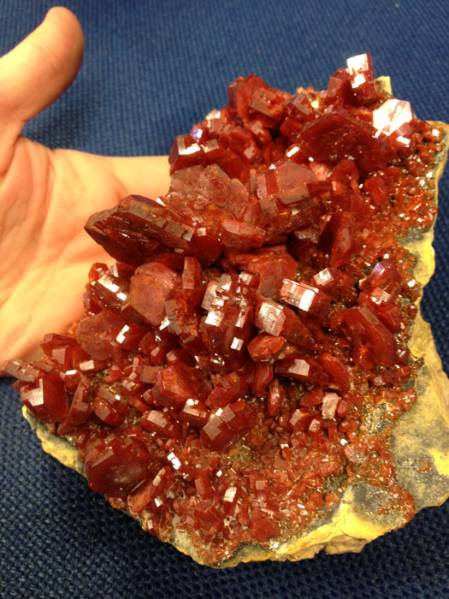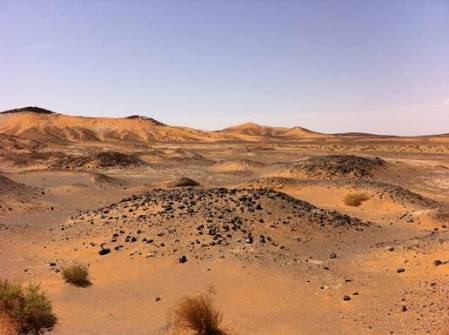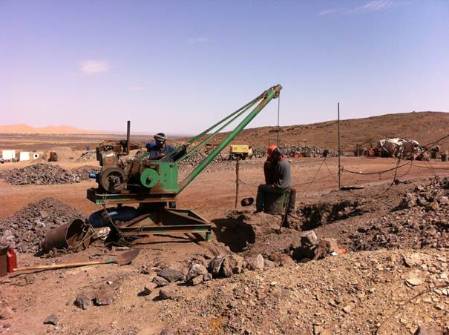Time for a guest blog from Mike Rumsey, to tell you all what the Mineralogists got up to on the days they split up from the Palaeontologists.
Having another geological commitment to attend I arrived in the middle of the night a couple of days after everyone else had settled into the Morrocco fieldtrip – a long taxi drive by darkness and a rough couple of hours sleep and then it was off into the field with the other mineralogists. (We split up so the palaeo people and the min people could get as much done as possible). First up was the amazing abandoned mining town of Angil, nestled in a steep valley once mined for its copper and lead content.
Looking over a town in the valley.
Although an incredible vista, the many hundreds of steps leading up to the top of the valley was difficult in the heat and having only had a few hours sleep – it was a real fieldtrip wake-up call! We found some representative material with our local guide and then moved onto the main important task for the day – Mibladen.
The Mibladen area is famous for beautiful bright red crystalline specimens of vanadinite, which are probably the best in the world, and as such Mibladen is well known to most mineralogists and it was great to visit such a famous locality. Vanadinite from here has been known for a long time, but most of the material that ends up in the UK is poorly located and is often just labelled vanadinite from Mibladen, Morocco - this is not really fit for some of the scientific purposes of the museum, so we wanted to collect material directly from a number of different outcrops, mines and workings so we could record exactly where subtly different specimens of vanadinite occurred.
Vanadinite
Another feature of the material that reaches the UK on the commercial market is that it has often been heavily prepared. This might involve cleaning in acids or selective trimming or removal of other less aesthetic mineral species that get in the way of the bright red vanadinite crystals. This is unfortunate as we are losing geologically relevant information when this happens, so I wanted also to obtain some ugly, fresh material that might have all sorts of natural alterations, erosion crusts and associated minerals combined that could tell us or future geologists something a little extra about this place than the readily available specimens.
After a few hours of driving between localities and getting some quick representative samples the day was complete before I knew it, but I had lots of samples and was happy - we met some really interesting people and saw some incredible hand-dug mines and pits in the middle of the desert where prospectors had been searching for vanadinite.
On the second split day from the palaeo guys, we mineralogists visited the area of M’fis and Taouz, M’fis is a famous area for barite specimens and Taouz is another area famous for its vanadinite. Both these places were really out in the middle of the desert and it was very, (very!) hot - a specific locality called the wulfenite vein at M’fis – was so open and exposed, it felt a bit like some horror film where we might have been abandoned in a desert oven.
The hot desert in M'fis
Still we got to it and collected some really interesting specimens from some more off the beaten track spots in M’fis including areas that have never really been written about or documented in any systematic fashion. At the main site of M’fis we picked up some good representative barite specimens and saw some pretty scary mining operations that I’m certain you would not see in the UK.
An example of scary mining operations
At Taouz we didn’t collect much as I had been lucky enough to visit the locality the previous year. However, we did get some nice specimens from the local miners and we got a quick tour inside the mine workings to see some of the vandinite in situ, both of which we documented to better illustrate the geological environment of the finds from my trip to Taouz the year before.
Analysis of the minerals is still ongoing, but it seems successful so far, with a few species being identified and/or documented for the first time at specific localities and in one case, possibly the first documented occurrence in Morocco… and perhaps the first even for the planet, which considering there are only 4800 known minerals is a fairly rare occurrence.
Huge thanks to Mike for writing this so I could share his experiences of Morocco!





